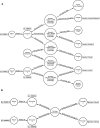An Outcome-Weighted Network Model for Characterizing Collaboration
- PMID: 27706199
- PMCID: PMC5051930
- DOI: 10.1371/journal.pone.0163861
An Outcome-Weighted Network Model for Characterizing Collaboration
Abstract
Shared patient encounters form the basis of collaborative relationships, which are crucial to the success of complex and interdisciplinary teamwork in healthcare. Quantifying the strength of these relationships using shared risk-adjusted patient outcomes provides insight into interactions that occur between healthcare providers. We developed the Shared Positive Outcome Ratio (SPOR), a novel parameter that quantifies the concentration of positive outcomes between a pair of healthcare providers over a set of shared patient encounters. We constructed a collaboration network using hospital emergency department patient data from electronic health records (EHRs) over a three-year period. Based on an outcome indicating patient satisfaction, we used this network to assess pairwise collaboration and evaluate the SPOR. By comparing this network of 574 providers and 5,615 relationships to a set of networks based on randomized outcomes, we identified 295 (5.2%) pairwise collaborations having significantly higher patient satisfaction rates. Our results show extreme high- and low-scoring relationships over a set of shared patient encounters and quantify high variability in collaboration between providers. We identified 29 top performers in terms of patient satisfaction. Providers in the high-scoring group had both a greater average number of associated encounters and a higher percentage of total encounters with positive outcomes than those in the low-scoring group, implying that more experienced individuals may be able to collaborate more successfully. Our study shows that a healthcare collaboration network can be structurally evaluated to characterize the collaborative interactions that occur between healthcare providers in a hospital setting.
Conflict of interest statement
The authors have declared that no competing interests exist.
Figures




References
-
- Centers for Medicare & Medicaid Services. Readmissions Reduction Program. Available from: http://www.cms.gov/Medicare/Medicare-Fee-for-Service-Payment/AcuteInpati....
-
- Care Coordination Measures Atlas Update. June 2014. Agency for Healthcare Research and Quality (AHRQ) Available from: http://www.ahrq.gov/professionals/prevention-chronic-care/improve/coordi....
-
- Institute of Medicine (IOM). Improving the Quality of Health Care for Mental and Substance-Use Conditions: Quality Chasm Series. 2006. Available from: http://www.ncbi.nlm.nih.gov/books/NBK19830/. - PubMed
-
- Spertus JA, Eagle KA, Krumholz HM, Mitchell KR, Normand SL. American College of Cardiology and American Heart Association methodology for the selection and creation of performance measures for quantifying the quality of cardiovascular care. Circulation. 2005;111(13):1703–12. 10.1161/01.CIR.0000157096.95223.D7 . - DOI - PubMed
-
- Yancy CW, Jessup M, Bozkurt B, Butler J, Casey DE Jr., Drazner MH, et al. 2013 ACCF/AHA guideline for the management of heart failure: a report of the American College of Cardiology Foundation/American Heart Association Task Force on Practice Guidelines. J Am Coll Cardiol. 2013;62(16):e147–239. 10.1016/j.jacc.2013.05.019 . - DOI - PubMed
MeSH terms
Grants and funding
LinkOut - more resources
Full Text Sources
Other Literature Sources

